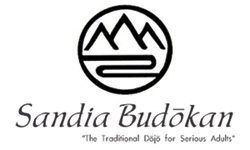Kenjutsu, or, "The art of the sword" is the most beautiful, elegant
and demanding of all the Japanese martial arts. The kenjutsu student trains
with an authentic Japanese razor-sharp blade in techniques of great complexity.
This quickly leads to the development of a strong spirit and fierce inner
discipline.
The style of swordsmanship taught at Sandia Budokan is the Itto Tenshin-ryu®.
We teach the use of the long sword (katana) and weapons used by the samurai.
The training includes live-blade kata, two-person practice with the wooden
sword (bokken) and live blade, and test cutting. You must acquire an authentic,
combat-ready Japanese sword to study this art.
Kenjustsu is for those who seek the most traditional martial arts and are ready to pursue precise, dedicated and deep physical training. It requires a moderate financial investment and significant personal commitment.
Mr. Bryan Godfrey, Kenjutsu Instructor.
Mr. Godfrey holds a senior teaching license in the Itto Tenshin-ryu and is head instructor of the Kenjutsu department of Sandia Budokan. He has studied Kenjutsu for over 20 years, and has been head instructor of the Sandia Budokan Kenjutsukai since 1994.
Kenjutsu Class Schedule
- Saturday 10:30-12:00 noon
- All-Dojo: last Saturday/month 9:30-11:30am
Do you own a japanese Sword?
For those of you who may have come into possession of an authentic Japanese
sword, we would like to offer a few words of advice. No matter how strong
a sword may look, they can actually be quite delicate. To preserve the
value of your sword, here are a few simple steps to follow.
First, Never touch the edge or sides of the blade with your fingers because oils from your skin can cause irreversible rust in a very short period of time.
Second, Never attempt to polish a Japanese sword with any standard stones or grinding wheels. Japanese swords are shaped differently from western swords and can be quickly ruined with just a few strokes from improper polishing tools.
Third, Never attempt to cut anything with your sword. Until properly trained, it is easy to strike an object in a manner that will cause the edge of the sword to chip, the sides of the sword to be scratched, or the entire end of the sword to bend. Also, minor flaws in the edge not visible to those with an untrained eye can cause a sword to break as a result of even minor contact, resulting in the tip of the sword flying off at high speed.
Observation of just a few of these tips will help preserve the value of
your sword. And while some swords are worth only hundreds of dollars, some
are worth hundreds of thousands. Don't take a chance on damaging a treasure.
At Sandia Budokan we will be happy to educate you about proper care, cleaning and use of your sword. Alternatively, there are numerous books available at quality bookstores that outline basic care and cleaning topics. Remember, you do not "own" a Japanese sword, you simply take care of it for the next generation.
Please feel free to continue on to the photo section where actual class sessions were photographed, giving you a brief view of some basic techniques.
If you should have any questions please feel free to stop by and observe a class, or drop us an email at info at sandiabudokan dot org

